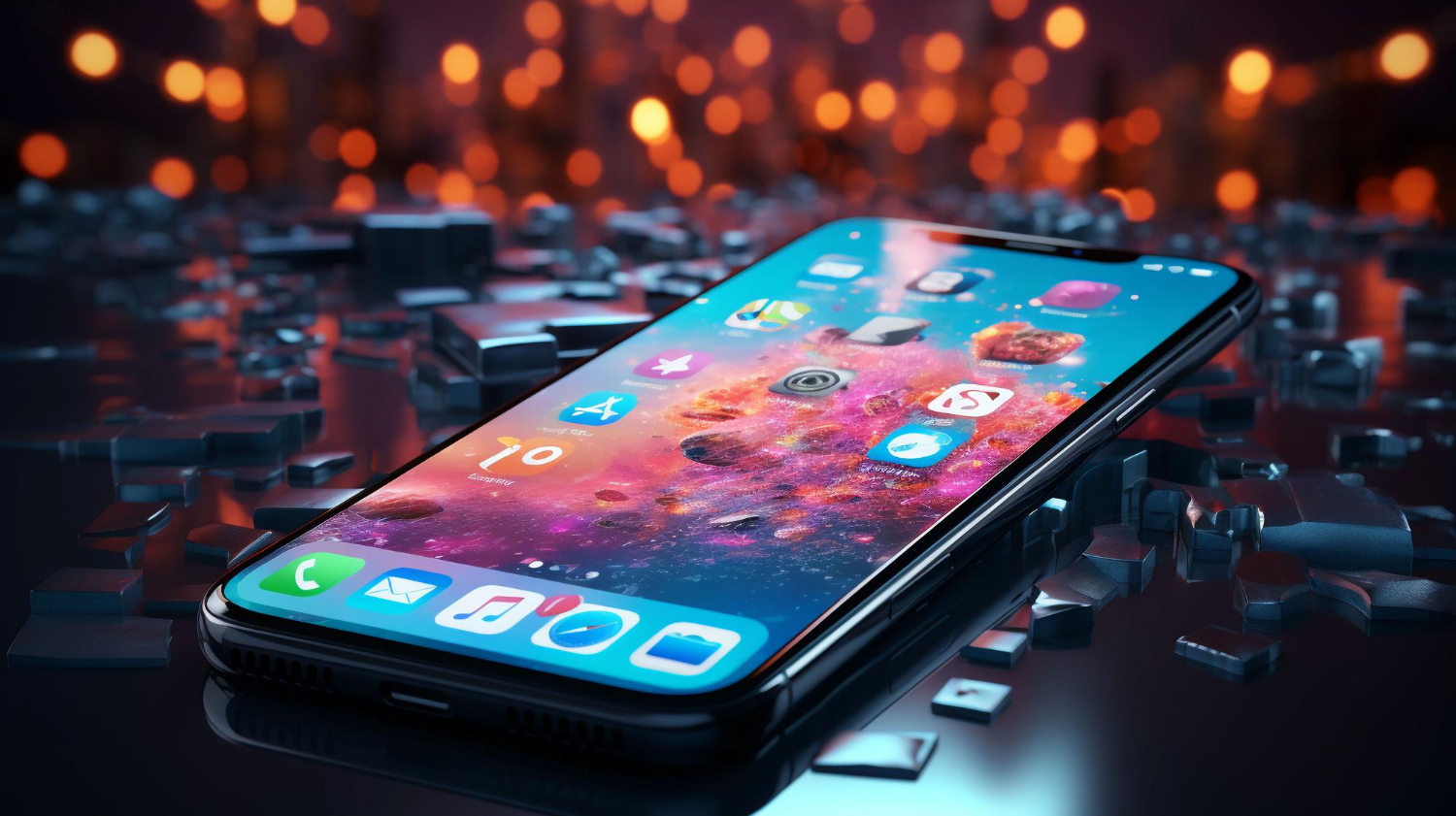BLOG
Mobile App Monetization Trends: Revenue Models and Success Stories
When embarking on entrepreneurial ventures, the foremost consideration revolves around potential revenues and the strategies required to achieve financial objectives.
The mobile market undeniably presents an alluring prospect in terms of potential earnings. According to Statista, global mobile app revenues surpassed 365 billion US dollars in 2018.
In 2019, apps generated a staggering 461.7 billion US dollars, with projections indicating a 2.5-fold increase to 935.2 billion US dollars by 2023.

While the industry’s revenues are soaring, some developers struggle to identify the most effective approaches to monetizing mobile apps.
In this blog post, we will dive deep into app revenue models and describe how to make money with apps.
What Is Mobile App Monetization?
App monetization involves selecting the right revenue generation strategy for your application and choosing the appropriate method to ensure a steady income stream.
The key to the success of any app monetization strategy is creating a phenomenal user experience, as revenue ultimately comes from satisfied users.
Offering a consistent and enjoyable user experience will encourage users to stay longer, as it increases their chances of spending time in the app.
To set your app up for success, define your app’s monetization strategy before launching.
This decision should align with the specific features and functionalities of your app, so make sure your app incorporates these features from the outset. Integrating them after the launch can be challenging and less effective.
Monetization Statistics to Be Aware Of:
In 2020, mobile app users collectively spent 3.5 trillion minutes on their mobile apps—this figure pertains solely to Android apps!
To provide some context, here are some statistics that shed light on the world of mobile app monetization:
- In 2022, global app revenue nearly touched $470 billion, with projections anticipating a surge to $613 billion by 2025.
- Gaming apps are the largest revenue generators, driving sixfold more margin revenue than the next highest category, social media apps.

- In 2021, 82% of mobile gaming app publishers employed in-app video ads, making it the most popular monetization method. For non-gaming apps, 76% embraced video ads. (Statista)
- In 2021, the top three countries for mobile app revenue were China ($56.7 billion), the US ($43 billion), and Japan ($20.7 billion). (Business of Apps)
- Love seems to be a lucrative theme, as Bumble and Tinder secured positions among the top five revenue-generating apps in 2021–2022. (data.ai)
- Most apps operate on the freemium model, accounting for 90% in the Apple Store and 95% in the Google Play Store. Despite this, they collectively amassed over $70 billion in revenue.
- During Q3 2022, the average consumer expenditure on mobile apps per smartphone stood at $4.86.

- In Q1 2022, the conversion rate from app installation to in-app purchases for non-gaming apps registered at 5.5%, while gaming apps trailed slightly at 2.6%.(Statista)
- As of September 2022, the top three iPhone apps in the App Store were Tinder, TikTok, and Honor of Kings, while the Google Play Store featured Coin Master, TikTok, and Candy Crush Saga as its top three apps.
Top Mobile App Monetization Trends
In-app Advertising
When mobile sales started gaining momentum in 2008, following the launch of the Apple App Store, digital advertising had already established itself as a monetization method on the internet.
App developers swiftly adapted by incorporating app banner ads, necessitating adjustments to fit the limited screen space of mobile devices.
These adaptations include interstitial ads, video ads, native ads, and text ads.
This app revenue model is one of the most popular app monetization strategies and shows no signs of slowing down. Predictions indicate that in-app ad revenues are poised to nearly triple by 2025, reaching $226 billion.

2. Interstitial Ads
With the advent of increasingly sophisticated analytics tools, app publishers now possess unparalleled insights into user behavior. These valuable insights have prompted them to shift their focus away from traditional in-app ads like banner ads. This move aims to counter banner blindness and address user disinterest.
One of the most effective alternatives to standard in-app ads is interstitial advertising. Unlike banner ads, interstitial ads are full-screen ads strategically placed at natural transition points within the user’s journey.
This mobile app monetization strategy yields optimal results when adhering to best practices. For example, interstitial ads should appear after a game level in gaming apps.
Interstitial ads are witnessing significant growth in eCPM (effective cost per mille), with a remarkable 34% increase observed between 2020 and 2021 on US Android devices alone.
3. Use Native Ads
Native ads have emerged as an increasingly prosperous advertising format; they blend in as regular feed posts.
This approach is particularly well-suited for platforms like news sites and social media.
These advertisements cause minimal disturbance to the user experience.
Moreover, they boast some of the most remarkable engagement rates. A study by eMarketer in 2018 indicated that the click-through rate (CTR) for native ads was 8.8 times higher compared to conventional display ads, underscoring their effectiveness.
4. Freemium Subscriptions
Belonging to the broader category of subscription apps, the “freemium” model stands out as a highly advantageous mobile app monetization approach.
In this model, users initially download an app for free but later get in-app purchase options that grant them exclusive access to premium features, additional content, or digital goods.
A stellar example of the freemium app subscription model is Spotify, the Swedish-born music app founded in 2006. Spotify’s inception aimed to provide an alternative to iTunes’ pay-per-song model and combat rampant illegal downloads.
While Spotify offers numerous premium app features to its free users, a monthly subscription fee unlocks a host of exclusive perks, including ad-free experiences.
Undoubtedly, Spotify is the king of the freemium app model regarding conversion rates. While most freemium apps typically convert around 2-5% of users from free to paying subscribers, research reveals that Spotify achieves an impressive 24% conversion rate for users initially opting for the free version.
The question arises: What makes Spotify’s approach so successful, and how can other developers harness this app business model to boost their app revenue?
The key to Spotify’s success lies in its unwavering commitment to experimentation, A/B testing, and user-centric focus.
By continuously refining its offerings, implementing dynamically evolving user interfaces, deploying behavioral prediction algorithms, and expanding its music catalog, Spotify has carved a path to sustained excellence in the competitive world of app monetization.
5. Premium Subscriptions
Premium mobile apps, or paid apps, operate on subscription models that ask users to pay a set fee after downloading. Consequently, the revenue generated directly correlates with the number of app downloads. Paid apps have demonstrated superior user engagement and customer acquisition rates.
6. In-App Purchases
It represents an increasingly popular monetization strategy, particularly in gaming applications. In-app purchases enable users to spend money to acquire features or items while immersed in a mobile game. The offerings can vary depending on the game genre, encompassing everything from extra lives and additional coins to unlocking previously inaccessible levels or hidden treasures.
While you can introduce in-app options at any point during gameplay, do this after carefully analyzing user behavior. Strategically present in-app purchase opportunities at the key moments when users might benefit from assistance so you can optimize your revenue stream.
However, it’s important to note that in-app purchases are not a one-size-fits-all solution. There are four primary categories of in-app purchases available to app developers, each with its own unique features and strategies. Select the most suitable one for your specific needs.
Types of In-App Purchases
1. Consumable:
Consumables represent the most common type of in-app purchase in mobile games. These include items such as in-game currency, health bonuses, or power-ups. As the name suggests, these in-app purchases deplete when used, so users can buy again. Many games offer a limited quantity of these consumables for free, making them an attractive option for users who value convenience and are willing to pay to save time.
2. non-Consumable:
Non-consumable in-app purchases grant users permanent access to their acquired items. Examples include unlocking hidden game levels, bonus characters, or cosmetic enhancements.
3. Auto-Renewing Subscriptions:
In-app subscriptions involve regular payments made by users to access premium content, akin to the freemium model mentioned earlier. You can configure subscriptions to last for varying periods and unlock everything from exclusive gameplay items to the premium version of the game.
4. Non-Renewing Subscriptions:
Like auto-renewing subscriptions, non-renewing subscriptions provide access to premium content. However, mobile users must manually renew these subscriptions when they expire.
Understanding the nuances of these in-app purchase categories empowers app publishers to make informed decisions that align with their specific app’s goals and audience preferences.
7. Affiliate Marketing
Once you’ve amassed a substantial and engaged user base, you might want to explore affiliate marketing and lead generation models as potential revenue streams.
Affiliate marketing involves displaying ads for other products within your app and earning a commission whenever your users click on an ad and purchase or become a lead.
Lead generation focuses on gathering user information from users who click on an ad and agree to share their details.
There are a multitude of affiliate marketing networks available, and you have the freedom to join as many as you’d like to maximize your earnings potential. However, much like with traditional ads, predicting your income can be challenging because user behavior is often unpredictable.
8. Sponsorships
As far back as 2012, Subway, a sandwich chain, sponsored PrePlay, a predictive gaming app, during Super Bowl XLVI, aiming to engage football fans and enhance its brand visibility. Marriot also entered the sponsorship arena by backing the launch of the Gayot.com mobile app, which featured professional restaurant reviews. Marriot leveraged this to promote its Rewards Chase Card to business travelers.
Some straightforward options include incorporating the sponsor’s logo in various areas of the screen, providing exclusive offers from the sponsor, or displaying sponsor advertisements.
9. Paid Apps
Another approach is offering paid apps, which require users to make a one-time payment to download the application. Following this payment, users gain access to the app’s full suite of features.
To ensure consistent and sustainable revenue streams, you must invest significant effort in expanding your user base.
Success Stories
Tinder: This dating app offers a free version with limited swipes and features while enticing users to subscribe to Tinder Plus or Tinder Gold for premium features like unlimited swipes, super likes, and more. Tinder’s clever use of the freemium model has made it a top-grossing app worldwide.
Candy Crush Saga: King, the developer behind Candy Crush Saga, generates significant revenue through in-app purchases of boosters and extra lives. The game’s addictive nature and well-timed IAP prompts have contributed to its immense success.
Spotify: Spotify’s freemium model offers users access to a vast music library with ads. By enticing users with the benefits of a premium subscription, including ad-free listening and offline downloads, Spotify has become a global music streaming leader.
TikTok: TikTok integrates native advertising seamlessly into its platform, promoting sponsored content in users’ feeds. This approach has helped TikTok maintain user engagement while providing brands with effective advertising opportunities.
Conclusion
Mobile app monetization is dynamic and ever-evolving. To succeed here, you must continuously adapt to emerging trends and user preferences. Whether you choose a freemium model, in-app advertising, subscriptions, or a combination of these strategies, the user experience should always be a top priority.
Study the successes of apps like Tinder, Candy Crush Saga, Spotify, and TikTok to gain valuable insights into effective monetization strategies. Remember that innovation, a deep understanding of your target audience, and a commitment to providing value will be key to your mobile app’s monetization success in the years to come.
Related Topics
Trending Topics
Want to build Super app for your business?



